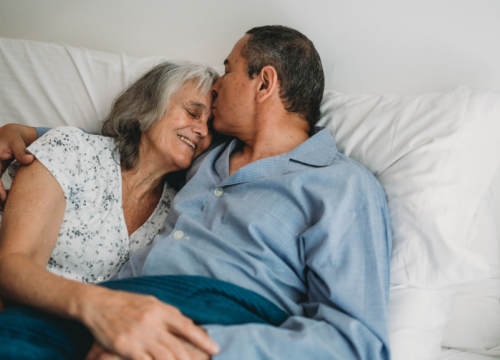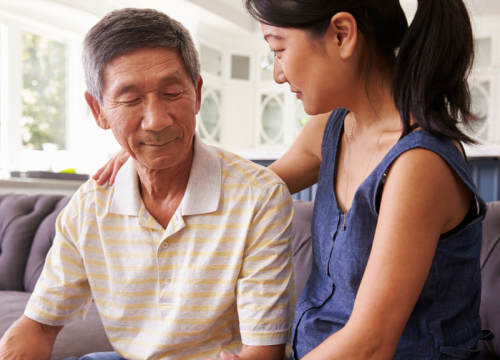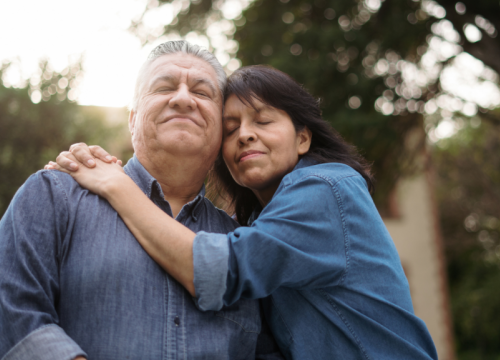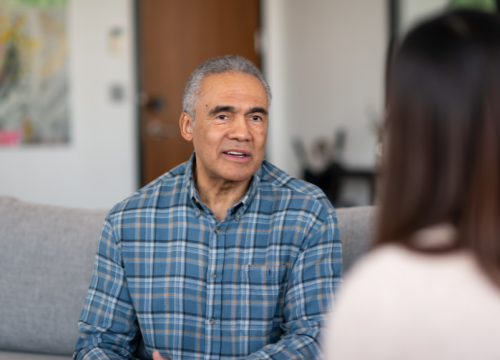Intimacy and PD
Parkinson’s disease (PD), like many chronic illnesses, can change the dynamics of a relationship, particularly when it comes to intimacy and sexuality. Exploring new ways to connect and communicate — whether you have PD or you care for someone who has PD — will help strengthen your relationship. Here are some suggestions for creating a deeper intimacy with your loved one.
Communication
Many couples do not openly talk about sex and intimacy, relying on predictable, nonverbal patterns of sexual expression (such as a look or touch). Given that PD may result in physical or emotional changes that can change these established patterns, maintaining open communication about feelings and emotions is essential.
PD may cause changes in facial expression that can be interpreted as lack of interest. This symptom, called “facial masking,” happens when the same stiffness and slowness that can impact walking and other activities impacts the muscles in the face of someone with PD. Because of this symptom, it is especially important to communicate your needs and listen openly to your partner’s needs.
We all have doubts about our appearance and insecurities about how our bodies may change over time. Express your love and appreciation for your partner regularly. Knowing that your partner still cares and needs you is of great comfort.
A strong friendship, based on caring and communication, is vital for any relationship. Share your thoughts, feelings and concerns, and encourage your partner to do the same. If you can learn to express your frustrations with one another, you will be less likely to build up anger and resentment.
Staying Close
Life and hectic schedules can get in the way of spending quality time together. Remember the things you enjoy doing together and remind one another what you love and appreciate about your loved one.
Parkinson’s can be unpredictable, so do not be disappointed if things do not go as expected. The most important thing is to remain flexible and sympathetic to our partner’s needs.
Patience and Understanding
As we grow older, our bodies may not respond or perform as they used to. Maturing is learning how to be comfortable with who you are and staying open to self-discovery.
Parkinson’s can either help bring you and your loved one closer together or push you apart, depending on how well you are able to cope with challenges. The strength of your bond prior to illness also plays a role. Acceptance and understanding play a large role in helping you both deal with any problems within your relationship.
Be patient. Remember that the goal in sexual intimacy is mutual enjoyment. Emphasize comfort and pleasure, not performance.
Sex
People with PD frequently experience sexual dysfunction. Any combination of Parkinson’srelated symptoms like pain, limitation of movement, fatigue and sleep disorders — coupled with emotional changes such as anxiety and depression — as well as medication side effects can trigger sexual dysfunction. PD symptoms can affect many aspects of sexuality, including intimacy and erotic experiences, thereby adding to a couple’s discord and general dissatisfaction.
People with PD and their partners are typically embarrassed and uneasy when bringing up sex to health care providers, often diminishing the topic because they feel it is not a life-threatening issue. However, when asked to rate a variety of disabling motor and non-motor symptoms, people with PD rated sexual dysfunction as the 12th out of 24 most bothersome Parkinson’s symptoms [Politis et al, 2010].
Expanding the Definition of Intimacy
Intimacy isn’t just about sexuality; it involves mutual respect for each other’s spirit and autonomy. You can still reap the benefits of closeness by sharing time together and using touch in affirming ways that are not reliant on sexual performance. Hold hands, hug or cuddle as an expression of love and intimacy.
Daily routine can be tireless and demanding. Take time for one another outside the required tasks. Simply sharing a meal or watching TV together can be a special event. Consider planning a day trip or a weekend getaway, to a destination that provides care assistance if necessary.
Hypersexuality and Parkinson’s Disease
One out of every six people with PD taking a dopamine agonist drug will develop compulsive behaviors. Known as impulse control disorders, these behaviors may include compulsive gambling or shopping, hoarding or hyper sexuality.
Hypersexuality can include demanding sex, talking about sex and your desire for sex at inappropriate times; cross-dressing; and having affairs outside of your committed relationship.
People living with PD who are taking dopamine agonists and have developed hypersexuality should discuss it with their neurologist. Usually decreasing the dose or complete discontinuation of dopamine agonists resolves impulse control problems.
Tips for Intimacy and Parkinson’s
Never be afraid to ask for help. Sex therapy, couples therapy and behavioral therapy can help you:
- Increase open sexual communication between partners.
- Plan the setting of sexual activity (including time, location, position and roles).
- Learn comfortable positions.
- Adapt new sexual roles.
- Find new solutions for physical limitations (such as, touch, arousal, orgasm).
- Perform intimacy training and erotic tasks.
- Practice sensate focus — a process of re-learning body sensations.
- Practice growing intimacy and satisfaction through sexual stimulation without intercourse, then begin to add it back in, known as the intercourse-outercourse approach.
- Work with medical staff to reduce the effects of medications on sexual function.
Not ready for therapy? Speak with your doctor or social worker about feelings of depression, concerns regarding changes in sexual performance or difficulties with current relationships.
Call our Helpline for more information at 1-800-4PD-INFO (473-4636).
Related Materials
Related Blog Posts

Intimacy Issues and Parkinson’s Disease 101

Relationships, Romance and Young-Onset Parkinson's















